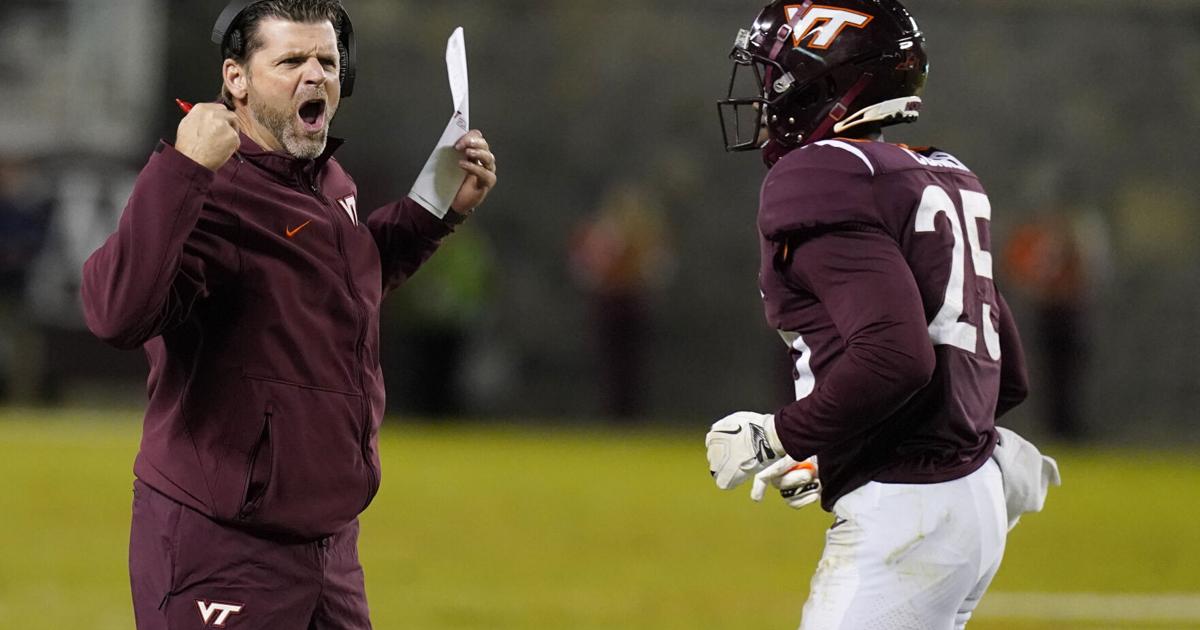BLACKSBURG – On a Thursday night 26 years ago, Virginia Tech handled West Virginia.
Led by Dwayne Thomas and Ken Oxendine, Tech rushed for 204 yards that night. It held WVU’s offense to just 2.9 yards per play and racked up eight sacks, five from the fearsome duo of Cornell Brown and J.C. Price. It forced four turnovers.
It had an identity.
This Thursday night, WVU came to Blacksburg again. This time, the Hokies struggled to run the ball, struggled to tackle the Mountaineers, struggled with penalties and struggled to stay in the game.
This time, they lost 33-10, their most lopsided loss in this rivalry since a 28-0 spanking in 1961 in Morgantown. The 65,000-plus fans who rocked Lane Stadium in the first quarter, only to depart early in the fourth, left Thursday without knowing what this year’s team’s identity is.
People are also reading…
“Just old school Virginia Tech football,” wide receiver Kaleb Smith said is what first-year coach Brent Pry wants his program to be known for.
Pry, a former graduate assistant under Frank Beamer and Bud Foster, has talked about restoring the Hokies to the style that made them Thursday night stars in the ‘90s – a powerful and productive running game, a dominating defense and, of course, Beamer Ball special teams units.
This Thursday night, Tech (2-2) tried to relaunch with that new/old Pry-dentity.
Instead, it sputtered.
“We’ve got to be a team that plays with fundamentals and techniques,” said Pry after his first home loss. “I feel like in tight situations we have a tendency to press and not play with fundamentals and techniques. We play outside the framework and we get out of sorts.”
Pry went as far as to describe his team’s response to challenges as “panic,” and certainly, there was cause for that Thursday night.
The Hokies allowed 203 rushing yards, were outgained 421-228, and – perhaps most disturbingly – were flagged for 15 penalties, costing them 132 yards.
Virginia Tech rushed for just 35 yards on 18 carries, a paltry 1.9 yards per rush. It was the team’s fewest rushing yards since managing just nine in a home loss to Pittsburgh in 2015.
Its inability to control the line of scrimmage showed most glaringly midway through the second quarter, when it failed to convert on either third or fourth-and-1.
“I’m disappointed but I’m also surprised,” said Pry. “I really thought we’d be able to run the ball a little bit better. We’ve got to be able to run the football.”
Virginia Tech’s defense gamely kept it in the game in the first half, rising up to hold West Virginia to field goals on its first three into the red zone. And the Hokies – thanks to a 28-yard touchdown pass from Grant Wells to Smith eight seconds into the first quarter – appeared headed to the locker room with a lead.
But, in an attempt to save time for his own 2-minute offense, Pry called timeout before WVU’s 35-yard field goal try with 1:50 left in the half. The Mountaineers’ Casey Legg made the kick, one of four field goals for him on the night, and Tech’s two-minute drill sputtered, going three-and-out.
That meant time on the clock for West Virginia, time it turned into a six-play, 70-yard scoring drive in just 50 seconds, one capped by JT Daniels’s 24-yard touchdown pass to Sam James with 11 seconds left in the half.
WVU (2-2) led 13-7 and never trailed again.
Tech’s offense never got back in gear in the second half. Its defense wore down.
That blue-collar identity Pry desires was nowhere to be found, a concerning absence considering the slate ahead of this team.
The Hokies play their next three games against ACC Coastal Division foes – at North Carolina, at Pittsburgh and home against Miami.
The players say they know what their coach wants from them, that they’ve embraced his vision.
“Just play Virginia Tech football, fly around, be aggressive,” said safety Chamarri Connor. “And just play our hardest every time we step on the field.”
Grasping it is one thing. The next step, will be displaying it in games.
Twitter: @RTD_MikeBarber

